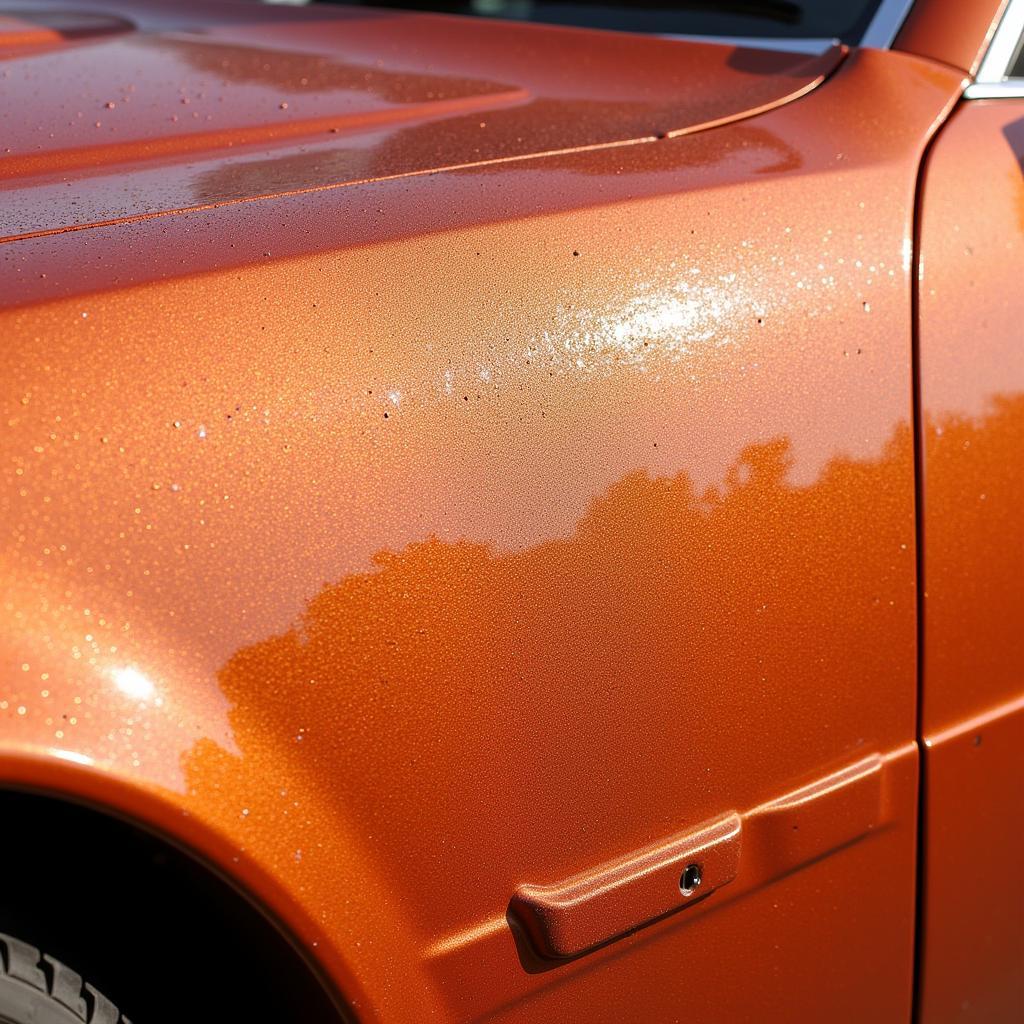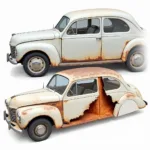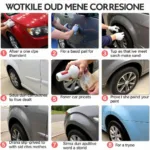Car paint stippling, also known as orange peel, is a common paint defect that resembles the bumpy texture of an orange. It occurs when the paint doesn’t flow out smoothly during application, resulting in a slightly textured finish. While a minor degree of orange peel is often acceptable, excessive stippling can detract from the overall appearance of your vehicle. This guide provides a comprehensive overview of how to repair car paint stippling, restoring your car’s finish to a smooth, glossy perfection.
Understanding Car Paint Stippling
Before diving into the repair process, it’s crucial to understand what causes car paint stippling. Several factors contribute to this imperfection, including incorrect paint viscosity, improper spray gun settings, environmental conditions like temperature and humidity, and insufficient flashing time between coats. Identifying the root cause can help prevent future occurrences. Essentially, stippling arises when the paint droplets don’t fully level out before drying, creating the characteristic bumpy texture.
 Close-up view of car paint stippling
Close-up view of car paint stippling
Gathering Your Materials
Repairing car paint stippling requires specific tools and materials. You’ll need high-quality wet sanding paper (ranging from 1500 to 3000 grit), a sanding block, a polishing compound, a polishing pad (wool or foam), a microfiber cloth, and car wax. Investing in quality materials ensures a professional-looking finish and minimizes the risk of further damage.
Step-by-Step Guide to Repairing Car Paint Stippling
- Wash and Dry: Thoroughly wash and dry the affected area. This removes any dirt or debris that could scratch the paint during the sanding process.
- Wet Sanding: Start with the finest grit sandpaper (e.g., 3000 grit) and gradually work your way down to coarser grits if necessary. Keep the sandpaper lubricated with water and sand in straight lines, applying even pressure. Regularly inspect the surface to avoid sanding through the clear coat.
- Polishing: After sanding, use a polishing compound with a polishing pad to remove any sanding marks and restore the shine. Apply the compound to the pad and work it onto the paint in circular motions.
- Final Polish: For an even glossier finish, follow up with a finer polishing compound or glaze.
- Waxing: Protect your newly repaired paint with a layer of car wax. This helps maintain the shine and provides a barrier against environmental contaminants.
Preventing Car Paint Stippling
Understanding the causes of stippling can help you avoid it in the future. Ensure the paint is mixed to the correct viscosity, adjust the spray gun settings appropriately, and allow sufficient flash time between coats. Controlling the environment during painting, such as maintaining a consistent temperature and humidity, can also significantly reduce the risk of stippling.
“Proper spray technique is crucial in preventing orange peel,” says renowned automotive painter, John Smith of Smith Auto Body. “Consistent air pressure, the correct distance from the surface, and overlapping each pass slightly are essential for a smooth, even finish.”
Conclusion
Repairing car paint stippling can be a straightforward process with the right tools and techniques. By following the steps outlined above, you can effectively remove the orange peel effect and restore your car’s paint to a smooth, glossy finish. Remember, prevention is always better than cure, so understanding the causes of stippling can help you avoid this issue in the future. Applying these techniques will have your car looking its best.
FAQ
- What causes orange peel in car paint? Several factors contribute, including incorrect paint viscosity, improper spray gun settings, environmental conditions, and insufficient flashing time.
- Can I repair car paint stippling myself? Yes, with the right tools and patience, you can achieve satisfactory results.
- What grit sandpaper should I use? Start with 3000 grit and gradually work your way down to coarser grits if necessary.
- Is it essential to wax the car after repairing stippling? Yes, waxing protects the newly repaired paint and maintains its shine.
- How can I prevent stippling in the future? Ensure correct paint viscosity, adjust spray gun settings, allow sufficient flash time, and control the painting environment.
- What is the difference between stippling and other paint defects? Stippling is characterized by a bumpy texture, while other defects like fish eyes or runs have different appearances.
- Can stippling occur with all types of car paint? Yes, although some paint types are more prone to it than others.
For further assistance, please contact us via WhatsApp: +1(641)206-8880, or Email: [email protected]. We have a 24/7 customer support team. We also have other articles on car repair available on our website, including detailing tips and advice on other common paint problems. We encourage you to explore our resources and learn more about maintaining your vehicle’s appearance.


